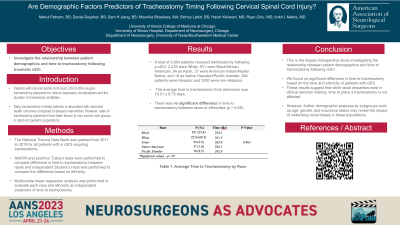Are Demographic Factors Predictors of Tracheostomy Timing Following Cervical Spinal Cord Injury?
Friday, April 21, 2023


Daniel Deysher, BS (he/him/his)
Medical Student
University of Illinois College of Medicine
ePoster Presenter(s)
Introduction: Patients with cervical spinal cord injury (cSCI) who develop respiratory failure require tracheostomy to reduce respiratory complications and the duration of mechanical ventilation. Early tracheostomy in these patients is associated with improved health outcomes compared to delayed intervention. Rates of tracheostomy placement have been shown to vary across race groups in adult and pediatric populations. In this study, we investigated the relationship between patient demographics and time to tracheostomy following traumatic cSCI.
Methods: The National Trauma Data Bank was queried from 2017 to 2019 for all patients with a cSCI requiring tracheostomy. Five-group one-way ANOVA and post-hoc Tukey's tests were performed to compare the difference in time to tracheostomy from hospital admission between races and independent Student’s t-test was performed to compare the difference based on ethnicity. Multivariate linear regression analysis was performed to evaluate each race and ethnicity as independent predictors of time to tracheostomy.
Results: A total of 3,664 patients received tracheostomy following a cSCI. 2,216 were White, 931 were Black/African American, 94 as Asian, 37 were American Indian/Alaska Native, and 18 as Native Hawaiian/Pacific Islander. 364 patients were Hispanic and 3300 were non-Hispanic. The average time to tracheostomy from admission was 10.01 ± 6.75 days. There was no significant difference in time to tracheostomy between races or based on ethnicity (p > 0.05).
Conclusion : To our knowledge, this is the largest retrospective study investigating the relationship between patient demographics and time to tracheostomy following cSCI. We found no significant difference in time to tracheostomy based on the race and ethnicity of patients with cSCI. These results suggest that while racial disparities exist in clinical decision making, time to place a tracheostomy is not affected. However, further demographic analyses by subgroups such as age, gender, and insurance status may reveal the impact of underlying racial biases in these populations.
Methods: The National Trauma Data Bank was queried from 2017 to 2019 for all patients with a cSCI requiring tracheostomy. Five-group one-way ANOVA and post-hoc Tukey's tests were performed to compare the difference in time to tracheostomy from hospital admission between races and independent Student’s t-test was performed to compare the difference based on ethnicity. Multivariate linear regression analysis was performed to evaluate each race and ethnicity as independent predictors of time to tracheostomy.
Results: A total of 3,664 patients received tracheostomy following a cSCI. 2,216 were White, 931 were Black/African American, 94 as Asian, 37 were American Indian/Alaska Native, and 18 as Native Hawaiian/Pacific Islander. 364 patients were Hispanic and 3300 were non-Hispanic. The average time to tracheostomy from admission was 10.01 ± 6.75 days. There was no significant difference in time to tracheostomy between races or based on ethnicity (p > 0.05).
Conclusion : To our knowledge, this is the largest retrospective study investigating the relationship between patient demographics and time to tracheostomy following cSCI. We found no significant difference in time to tracheostomy based on the race and ethnicity of patients with cSCI. These results suggest that while racial disparities exist in clinical decision making, time to place a tracheostomy is not affected. However, further demographic analyses by subgroups such as age, gender, and insurance status may reveal the impact of underlying racial biases in these populations.
